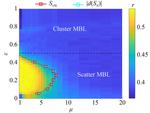Frontiers of Physics ( IF 6.5 ) Pub Date : 2024-03-01 , DOI: 10.1007/s11467-023-1384-1 Jie Chen , Chun Chen , Xiaoqun Wang

|
Many-body localization (MBL) of a disordered interacting boson system in one dimension is studied numerically at the filling faction one-half. The von Neumann entanglement entropy SvN is commonly used to detect the MBL phase transition but remains challenging to be directly measured. Based on the U(1) symmetry from the particle number conservation, SvN can be decomposed into the particle number entropy SN and the configuration entropy SC. In light of the tendency that the eigenstate’s SC nears zero in the localized phase, we introduce a quantity describing the deviation of SN from the ideal thermalization distribution; finite-size scaling analysis illustrates that it shares the same phase transition point with SvN but displays the better critical exponents. This observation hints that the phase transition to MBL might largely be determined by SN and its fluctuations. Notably, the recent experiments [A. Lukin, et al., Science 364, 256 (2019); J. Léonard, et al., Nat. Phys. 19, 481 (2023)] demonstrated that this deviation can potentially be measured through the SN measurement. Furthermore, our investigations reveal that the thermalized states primarily occupy the low-energy section of the spectrum, as indicated by measures of localization length, gap ratio, and energy density distribution. This low-energy spectrum of the Bose model closely resembles the entire spectrum of the Fermi (or spin XXZ) model, accommodating a transition from the thermalized to the localized states. While, owing to the bosonic statistics, the high-energy spectrum of the model allows the formation of distinct clusters of bosons in the random potential background. We analyze the resulting eigenstate properties and briefly summarize the associated dynamics. To distinguish between the phase regions at the low and high energies, a probing quantity based on the structure of SvN is also devised. Our work highlights the importance of symmetry combined with entanglement in the study of MBL. In this regard, for the disordered Heisenberg XXZ chain, the recent pure eigenvalue analyses in [J. Suntajs, et al., Phys. Rev. E 102, 062144 (2020)] would appear inadequate, while methods used in [A. Morningstar, et al., Phys. Rev. B 105, 174205 (2022)] that spoil the U(1) symmetry could be misleading.
中文翻译:

无序玻色-哈伯德链的本征态性质
一维无序相互作用玻色子系统的多体定位(MBL)在填充派二分之一处进行了数值研究。冯·诺依曼纠缠熵S vN通常用于检测 MBL 相变,但直接测量仍然具有挑战性。基于粒子数守恒的U (1)对称性, S vN可以分解为粒子数熵S N和构型熵S C。针对局域相中本征态S C接近于零的趋势,我们引入了一个描述S N与理想热化分布的偏差的量;有限尺寸尺度分析表明,它与S vN具有相同的相变点,但显示出更好的临界指数。这一观察结果表明,向 MBL 的相变可能很大程度上是由S N及其波动决定的。值得注意的是,最近的实验[A.卢金等人。 ,科学364, 256 (2019); J.莱昂纳德等人。,纳特。物理。 19, 481 (2023)]证明这种偏差可以通过SN测量来测量。此外,我们的研究表明,热化态主要占据光谱的低能部分,如定位长度、间隙比和能量密度分布的测量所示。玻色模型的低能谱与费米(或自旋XXZ)模型的整个谱非常相似,适应从热化态到局域态的转变。同时,由于玻色子统计,该模型的高能谱允许在随机势背景中形成不同的玻色子簇。我们分析了所得的本征态特性并简要总结了相关的动力学。为了区分低能和高能的相区,还设计了基于S vN结构的探测量。我们的工作强调了对称性与纠缠相结合在 MBL 研究中的重要性。在这方面,对于无序的海森堡XXZ链,最近的纯特征值分析[J.桑塔斯等人。,物理。 Rev. E 102, 062144 (2020)] 似乎不够充分,而 [A. Rev. E 102, 062144 (2020)] 中使用的方法似乎不够充分。晨星等人。,物理。 Rev. B 105, 174205 (2022)] 破坏了U(1) 对称性可能会产生误导。











































 京公网安备 11010802027423号
京公网安备 11010802027423号